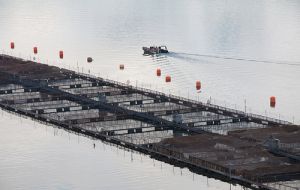MercoPress. South Atlantic News Agency
Aquaculture more efficient than livestock production, says WorldFish Centre
 Salmon farms in the south of Chile
Salmon farms in the south of Chile WorldFish Centre and Conservation International (CI) have revealed a comprehensive analysis exploring the environmental impact of the world's major aquaculture production systems and species and gives an unprecedented global assessment of trends and impacts. The results from the two-year study show that aquaculture is more efficient than other forms of animal protein production such as livestock.
The report, “Blue Frontiers: Managing the environmental costs of aquaculture,” was released with a companion policy recommendations paper at the Association of Southeast Asian Nations, Southeast Asian Fisheries Development Centre (ASEAN SEAFDEC) Conference on “Sustainable Fisheries for Food Security Towards 2020” in Bangkok, Thailand.
The report's major findings include that the environmental impact of aquaculture varies dramatically by country, region, production system and species, and that aquaculture is more efficient and less damaging to the environment than other animal protein production systems such as beef and pork, and may be one of the most important sources of protein for humans in many parts of the developing world.
Vast room for improvement exists through identifying and sharing best practices, increasing investment in innovation and reinforcing policies and regulations, the report explains.
The report used all available data from 2008 and compared aquaculture's global demands across a wide variety of species groups, geographical features, feed types and production systems. Scientists compared and contrasted 75 different types of species-production systems to determine their environmental impacts on acidification, climate change, energy demand, land-use demand and other ecological factors.
Researchers established, for example, that species farmed with the highest environmental impact include eel, salmon, and shrimp and prawns due to the significant energy and fish feeds required; aquaculture with the lowest/least environmental impact include mussels, oysters, molluscs and seaweed; and aquaculture makes up a significant majority of all consumed seaweed (99%), carps (90%) and salmon (73%) and delivers half (50%) of the total global supply of tilapia, catfish, molluscs, crabs and lobsters.
“This report offers the most comprehensive analysis of global aquaculture ever undertaken, and illustrates the opportunities and challenges that lie ahead,” said Dr Stephen Hall, lead author of the report and Director General of the WorldFish Centre.
As well, the results demonstrate that aquaculture products contribute less per unit weight to global emissions of nitrogen and phosphorus than pork and beef, and that fish, as compared to pork or beef, convert a higher percentage of the food they eat into consumable protein, which curbs waste.
The report offers multiple recommendations to policy makers, development and environmental groups and industry professionals, such as ensuring the regulatory environment keeps pace and supports environmental considerations in aquaculture growth, developing the necessary capacity in national agencies and careful monitoring of the sector so that support and investment are appropriate to the market opportunities. (FIS).-




Top Comments
Disclaimer & comment rules-

Read all commentsI have posted extensively on this topic @ BBC Earth Watch, eg:
Jun 16th, 2011 - 05:17 pm 0http://www.bbc.co.uk/news/science-environment-13756853
but recent restrictions on the posting criteria have forced me to leave BBC blog-environments.
But our treats here are all farmed - Chilean Salmon, and Brasilian Tilapia and prawns.
. . . . yes, I know about the Anchovoeta.
Commenting for this story is now closed.
If you have a Facebook account, become a fan and comment on our Facebook Page!